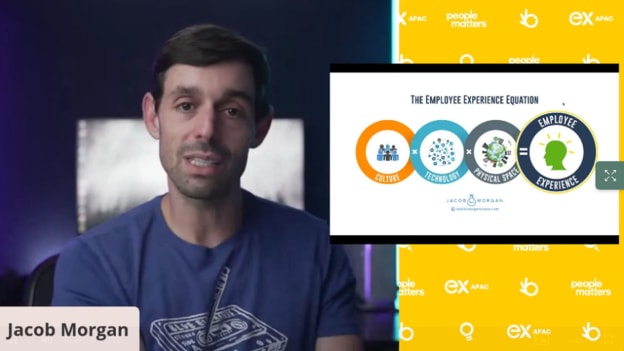The EX equation: culture + technology + physical space

The employee engagement cycle is one of the “most outdated concepts inside of companies”, says futurist and best-selling author Jacob Morgan. Instead, employee experience is the new business imperative: and there's even a handy formula for organisations seeking to shift towards a more human-centric workplace that really matches with what employees want and need.
Speaking at People Matters EX APAC Conference 2021, Morgan said: “Every company is a combination of three things that you can control in shape and design to create an amazing experience for your people. And those three things are culture, technology and physical space.”
30% physical space, 30% technology, 40% culture
What do these three components of employee experience actually involve? The easiest one to visualise and implement has traditionally been physical space, but that's become a little complicated in the hybrid working model. The organisation can hardly build a space for employees who are working remotely. But that doesn't mean the organisation can't provide guidance. Organisations, Morgan suggested, can teach employees how to create that physical space: how to set up their home studios, how to be productive at home, give them access to whatever equipment they might need to get their jobs done.
“Even if an employee is not coming into an office, you as an organisation still have a responsibility to help make sure that the employee is able to shape their space in a way that is allowing them to be productive and engaged.”
Next is technology, which confers both advantages and disadvantages: it simultaneously connects everyone within a global organisation, while putting them at a disconnect from human interaction. It streamlines workflows and makes it easier for people to do their jobs, but sidelines the dialogue and relationship building that would otherwise happen.
The upside to this, said Morgan, is that COVID-19 has accelerated the quality and quantity of technological adoption to the point that now, one and a half years in, organisations are using consumer-grade technology for work. What does consumer-grade mean?
“Tools that are beautiful, they're easy to use, they're intuitive, things that we would use in our personal lives,” he said.
“As an organisation, if you want to create great experiences for your people, when it comes to technology, make sure that your employees have the tools and the resources to do their job anywhere, any time, and on any device.”
Finally there is culture, the largest and also the most difficult to define or implement – unlike physical space and technology, it's not just a matter of pumping in resources. Morgan likes to describe culture as the “side effects of working for a company”, something that can be good or bad.
“Culture is how you feel working for the organisation, culture is how you feel working for the leader,” he said.
Where do companies start?
The EX equation is a useful set of filters for evaluating organisational decisions that affect people, Morgan suggested. “Run your decision through these three filters. How is this going to impact the spaces in which employees work? How is this going to impact the tools and resources employees have access to to do their jobs? And how is this going to impact how employees feel working for us as an organisation or for us as leaders?”
The leadership aspect is particularly important, he added, because those are the people who have the most power to affect other employees' lives and whose actions are the most visible. And here, HR can make a difference because they have a say in who becomes leaders.
“Look at who's being promoted in your company,” he advised. “Are you promoting people who make the most amount of money? Are you promoting people who've been at the company the longest? Are you promoting people who are the best at navigating office politics and bureaucracy?”
If any of these are the case, he said, the organisation needs to change how it views leadership and the responsibility of looking after other people. “We have to start by thinking about who we promote inside of our organisations, making sure that we have people in positions of power who actually care.”
Finally, he suggested a framework for leaders who want to build their own future of work.
- Challenge your assumptions around how work gets done
- Create a team to lead the effort
- Define what the future of work looks like to your organisation
- Have conversations about that future with the rest of the company
- Experiment and collect data
- Implement change














